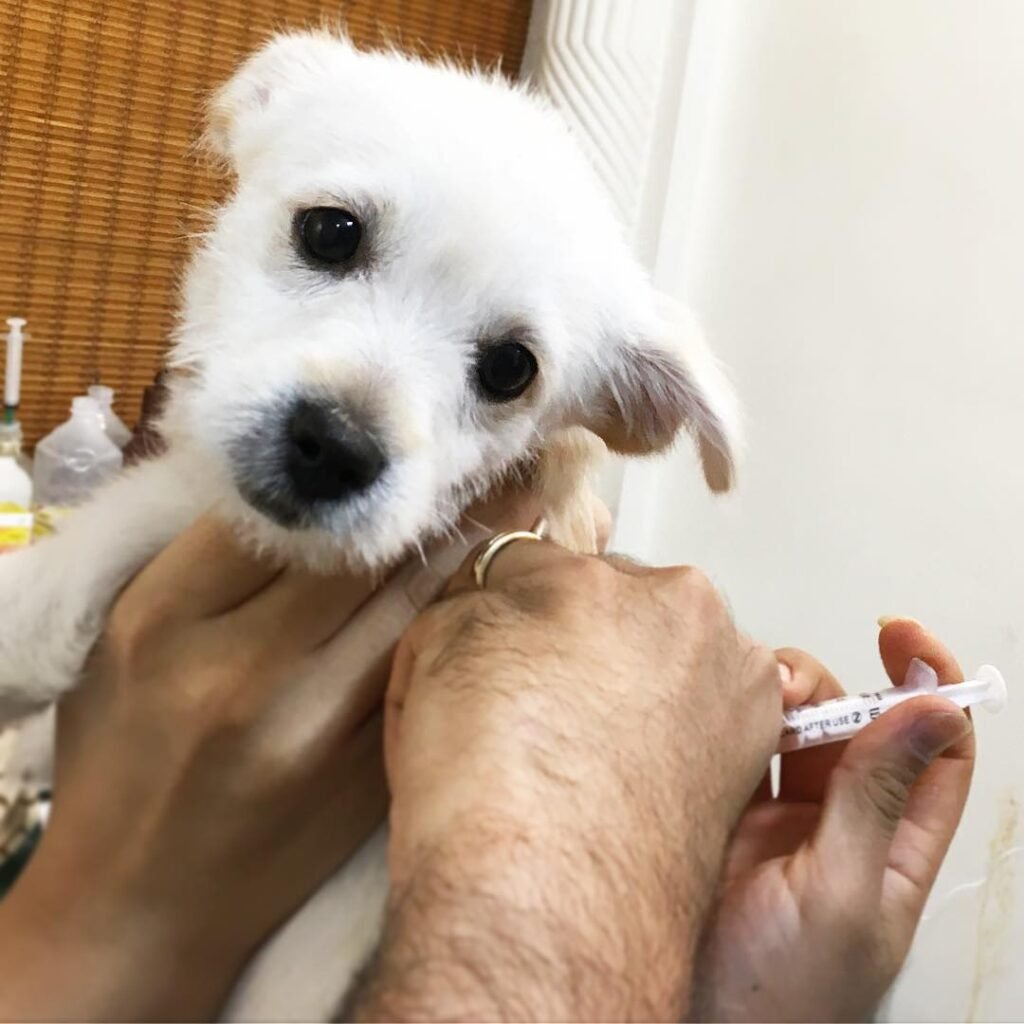Your diabetic dog has managed to keep relatively healthy with insulin therapy, moderate exercise, and the vet-recommended high-protein diet. The other day, however, your dog got really sick and had to be rushed to the vet, spending a few days hospitalized. Your dog’s vet gave a diabetic ketoacidosis diagnosis (DK).
So, what is diabetes ketoacidosis?
This article is an A-Z guide on diabetes ketoacidosis. We tell every little detail about the nature, causes, symptoms, diagnosis, treatment, and prevention of diabetic ketoacidosis in dogs with diabetes mellitus. Let’s start with the fundamental question: What is diabetic ketoacidosis in dogs?
What is Diabetic Ketoacidosis?
Diabetic ketoacidosis is a potentially fatal medical emergency in dogs with diabetes mellitus caused by low insulin in the body and its failure to regulate blood sugar (glucose) levels correctly.

Diabetes ketoacidosis is a common occurrence in dogs with diabetes mellitus. A study found that 65% of dogs had diabetes ketoacidosis at the time they were diagnosed with diabetes mellitus.
Because it is deadly, diabetes ketoacidosis should be treated immediately!
What Causes Diabetic Ketoacidosis and How does it Happen?
Diabetic ketoacidosis is caused by the body’s inability to control glucose levels when insulin levels drop. As a result, glucose accumulates in the blood, and the liver produces ketone bodies for the emergency supply of energy to the body.
Ketone bodies are alternative energy sources that the liver makes by breaking down fats and creating energy when glucose is in short supply in the body. When ketones break down, they cause an imbalance in your dog’s body pH, producing a more acidic environment (acidosis).
Because dogs cannot maintain the body fluid and electrolyte balance in a low pH body environment, diabetic ketoacidosis happens, producing deadly symptoms such as an abnormal heart rate and irregular muscle function.
It is important to note that low insulin in the body (which leads to diabetic ketoacidosis in dogs) can be triggered by other underlying conditions, including:
- Uncontrolled/untreated diabetes mellitus.
- Stress – stress hormones interfere with insulin activity.
- Preexisting diseases (including heart disease, heart and kidney failure, cancer, Addison’s disease, asthma, and Cushing’s disease (hyperadrenocorticism).
- Pancreatitis – the inflammation of the pancreatic gland that produces insulin to regulate blood sugar levels.
- Body inflammations.
- Infections (including skin infections, respiratory infections, and UTIs).
- Surgery.
- Fasting.
- Dehydration.
Signs and symptoms of Diabetic Ketoacidosis in Dogs
The diabetic ketoacidosis medical emergency caused by high acidity levels and uncontrolled blood sugar levels in your dog’s body manifests in the following clinical signs and symptoms:
- Polydipsia (increased thirst) in some cases the absence of thirst (adipsia).
- Polyuria (increased urination).
- Anorexia (lack of appetite).
- Cachexia (extreme body weakness and weight loss due to severe disease).
- Muscle wasting and abnormal muscle function.
- Vomiting.
- Depression.
- Poor coat quality (often with dandruff).
- Irregular heartbeat and abnormally rapid breathing.
- Jaundice (yellowing of the eyes, skin, and gums).
- Dehydration.
- Sudden blindness or impaired vision.
- Hypothermia (low body temperature).
- Sweet breath.
Because many of these symptoms can also manifest with other medical conditions, it is important that your dog is immediately seen by a vet and given a proper diagnosis.
Diabetic Ketoacidosis Diagnosis
There are several tests and techniques used to diagnose diabetic ketoacidosis in dogs:

Dog Health History
The first thing your dog’s vet will do if he suspects diabetic ketoacidosis is ask you to give a complete health history of your dog. Narrating your dog’s health history in cases of suspected diabetic ketoacidosis mainly focuses on the following details:
- The onset of the symptoms.
- The nature of the symptoms (frequency, severity, co-occurrence, etc.).
Your dog’s vet will then perform a complete physical examination on your dog before proceeding to other necessary tests.
Complete Blood Count (CBC)
A CBC test in suspected diabetic ketoacidosis examines the following:
- Blood sugar levels – dogs with diabetic ketoacidosis have abnormally high blood sugar levels.
- Blood ketone values – dogs with diabetic ketoacidosis have abnormally high blood ketone values.
- Abnormalities in blood gas due to low pH levels and extreme electrolytes imbalance (blood electrolytes include potassium, sodium, chloride, phosphorous).
- High white blood cell count, especially when diabetic ketoacidosis is accompanied or triggered by other infections.
A CBC test will also reveal other issues related to diabetic ketoacidosis, including:
- High blood cholesterol levels.
- High liver enzymes.
- Accumulation of nitrogenous waste products (urea) in the blood.
- Low sodium levels (hyponatremia).
- Low phosphorous levels (hypophosphatemia).
Urinalysis
Urinalysis in suspected diabetic ketoacidosis test the following:
- Ketone values in the urine – dogs with diabetic ketoacidosis have abnormally high urine ketone values (ketonuria).
- Blood sugar levels – dogs with diabetic ketoacidosis have abnormally high glucose levels in the urine (glucosuria).
Tests for underlying diseases and infections may also be carried out to help understand diabetic ketoacidosis triggers.
Treatments for Diabetic Ketoacidosis in Dogs

The treatment of diabetic ketoacidosis happens in two stages:
Stage 1: Initial Treatment
During the first days of diabetic ketoacidosis, your dog will require quick and intense management of the condition.
Dogs with mild diabetic ketoacidosis and who are alert and well hydrated will not require hospitalization. They are treated with insulin injections to restore normal blood sugar levels (80-120 mg/dc or 4.4-6.6 mmol/L). Treating mild diabetic ketoacidosis with insulin injections may take a few days.
Dogs with severe DKA must be hospitalized to receive the following treatment procedures:
- Control of high blood sugar levels – dogs are given short-acting insulin, and their glucose levels are checked every 1-3 hours to determine if the dog is responding to treatment.
- Fluid therapy for rehydration.
- Regulation of blood salts (electrolytes), especially potassium supplementation. Low potassium levels, also known as (hypokalemia) is a life-threatening complication associated with diabetic ketoacidosis.
At this point, your dog’s vet will also do additional tests like x-ray imaging to examine your dog for contributing health conditions such as pancreatitis or liver disease.
The vet will also use:
- Antibiotics to treat underlying infections.
- Diuretics to increase urine production and control blood sugar levels in the body.
- Catheters to regularize urination.
Stage 2: Ongoing Treatment
Ongoing treatment involves regular insulin administration to keep blood sugar levels under control.
You’ll need to monitor your dog’s blood sugar by consistently measuring the glucose levels and ensuring they are within normal range.
Dietary management is also recommended, which you can work out with your dog’s vet.
What Secondary Problems might Occur with DKA

Several secondary complications can occur with diabetic ketoacidosis. These are a major part of why hospitalization is advised in severe cases. These complications include:
- Heart failure and/or kidney failure.
- Hypokalemia (low potassium levels) with risks of heart failure, muscle collapse, paralysis, and respiratory failure.
- Hypoglycemia (low blood sugar).
- Hypophosphatemia (low phosphorous levels) which comes with risks like respiratory failure, irregular heart rate, destruction of red blood cells, and death of muscle tissue.
- Swelling of the brain.
- Fluid accumulation in the lungs.
How do I Prevent Diabetic Ketoacidosis in my Dog?
Managing and monitoring the blood glucose levels is the primary way of preventing diabetic ketoacidosis from occurring or recurring.
Preventive blood glucose monitoring in dog diabetic ketoacidosis should be done through:
- Correct insulin dosage.
- Home monitoring for blood glucose through regular testing.
- Consistently working with your dog’s vet to regulate insulin dosages based on the glucose level readings that are recorded daily and over a number of days.
- A low-fat prescription diet with complex carbohydrates and more fiber.
- Staying attentive to diabetic ketoacidosis recurrence symptoms and reporting the situation to the veterinarian as soon as any of the signs are noted.
Are there Home Treatments for DKA in Dogs?
Home monitoring of glucose levels in your dog’s blood is a primary practice in preventing the occurrence or recurrence of diabetic ketoacidosis.Any improvised home treatments are a definite no-no. Diabetes ketoacidosis is a potentially deadly medical emergency and should only be treated by a professional veterinarian.
Diabetic Ketoacidosis Prognosis
70% of dogs treated for diabetic ketoacidosis are discharged successfully after 5-6 days of hospitalization. Unfortunately, 7% of dogs discharged after successful treatment of diabetic ketoacidosis suffer a recurring episode.
Considering the complexity of this medical emergency the long-term prognosis for diabetic ketoacidosis is generally unfavorable. As such, dog owners need to be extra vigilant during and after treatment.
Any signs of complication during treatment or of recurrence after treatment should be reported immediately to the veterinarian.
Dogs Life Expectancy with DKA
It is difficult to set a life expectancy for your diabetic dog after it has suffered diabetic ketoacidosis. However, this medical emergency usually happens in the final stages of diabetes when diabetes is more difficult to manage.
Besides, dogs with diabetes are given a median life expectancy of 2 years with treatment and less if untreated. As such, a dog with diabetic ketoacidosis has a lower life expectancy than 2 years.
Are some Dogs more Prone to Diabetic Ketoacidosis?

Any dog with diabetes is at risk of suffering from DKA. However, dogs with the following characteristics are more prone to develop it:
- Older dogs, the median age for dogs at risk is 8 years.
- Female dogs, especially those not spayed, as hormone changes can make diabetes difficult to control.
- Some dog breeds, including Miniature Poodles and Dachshunds.
- Dogs with pre-existing conditions, including acute pancreatitis, Cushing’s disease, and UTIs.
Diabetic Ketoacidosis in Dogs Cost
Diabetic ketoacidosis in dogs is a costly medical emergency. According to PetHealthNetwork, the cost of blood and urine tests for diagnosing diabetes ketoacidosis, the complex and aggressive treatments, and hospitalization can run as high as $3000-$5000.
Considering the high risk of recurrence, this cost could be doubled if your dog has to be tested, hospitalized, and treated for diabetic ketoacidosis more than once.
Final Thoughts
Diabetic ketoacidosis in dogs is a serious medical emergency that requires immediate medical attention.
The information provided in this article is crucial for dog owners, as your dog’s survival depends on how first you act when diabetic ketoacidosis signs are noted and how well you monitor your dog’s progress after the vet has treated the dog for diabetic ketoacidosis.

Comments are closed.